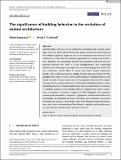Files in this item
The significance of building behavior in the evolution of animal architecture
Item metadata
| dc.contributor.author | Sugasawa, Shoko | |
| dc.contributor.author | Pritchard, David J. | |
| dc.date.accessioned | 2022-03-28T11:33:04Z | |
| dc.date.available | 2022-03-28T11:33:04Z | |
| dc.date.issued | 2022-03-24 | |
| dc.identifier | 278544859 | |
| dc.identifier | cf427b96-2dbc-49f7-82fb-3f75e798c73b | |
| dc.identifier | 000772684200001 | |
| dc.identifier | 85127345887 | |
| dc.identifier.citation | Sugasawa , S & Pritchard , D J 2022 , ' The significance of building behavior in the evolution of animal architecture ' , Advances in Ecological Research , vol. Early View . https://doi.org/10.1111/1440-1703.12309 | en |
| dc.identifier.issn | 0912-3814 | |
| dc.identifier.other | RIS: urn:96118B696A4583076E308019B17169E6 | |
| dc.identifier.other | ORCID: /0000-0003-4452-1177/work/110911969 | |
| dc.identifier.uri | https://hdl.handle.net/10023/25116 | |
| dc.description | This work wassupported by Biotechnology and Biological Sciences Research Council Discovery Fellowship (BB/S01019X/1) to S.S. | en |
| dc.description.abstract | Animals make a diverse array of architectures including nests, bowers, roosts, traps, and tools. Much of the research into animal architecture has focused on the analysis of physical properties such as the dimensions and material of the architectures, rather than the behavior responsible for creating these architectures. However, the relationship between the architecture itself and the construction behavior that built it is not straightforward, and overlooking behavior risks obtaining an incomplete or even misleading picture of how animal architecture evolves. Here we review data about animal architectures broadly, with a particular focus on building by birds and social insects. We then highlight three ways in which a better understanding of building behavior could benefit the study of animal architecture: by clarifying how behavior leads to physical properties; by examining the costs and benefits of building behavior; and by determining the role of learning and how this interacts with selection on behavior. To integrate questions about building behavior alongside those about architectures, we propose a framework inspired by Niko Tinbergen's four questions, examining the mechanistic, ontogenetic, phylogenetic, and functional basis of animal building. By integrating the study of behavior and architecture across levels of analysis, we can gain a more holistic view of the behavior-architecture interactions, and a better understanding of how behavior, cognition, and evolution interact to produce the diversity seen in animal architecture. | |
| dc.format.extent | 9 | |
| dc.format.extent | 1580789 | |
| dc.language.iso | eng | |
| dc.relation.ispartof | Advances in Ecological Research | en |
| dc.subject | Animal architecture | en |
| dc.subject | Animal cognition | en |
| dc.subject | Building | en |
| dc.subject | Construction behavior | en |
| dc.subject | Ethology | en |
| dc.subject | QH301 Biology | en |
| dc.subject | 3rd-DAS | en |
| dc.subject.lcc | QH301 | en |
| dc.title | The significance of building behavior in the evolution of animal architecture | en |
| dc.type | Journal article | en |
| dc.contributor.sponsor | BBSRC | en |
| dc.contributor.institution | University of St Andrews. School of Biology | en |
| dc.identifier.doi | 10.1111/1440-1703.12309 | |
| dc.description.status | Peer reviewed | en |
| dc.identifier.grantnumber | BB/S01019X/1 | en |
This item appears in the following Collection(s)
Items in the St Andrews Research Repository are protected by copyright, with all rights reserved, unless otherwise indicated.

